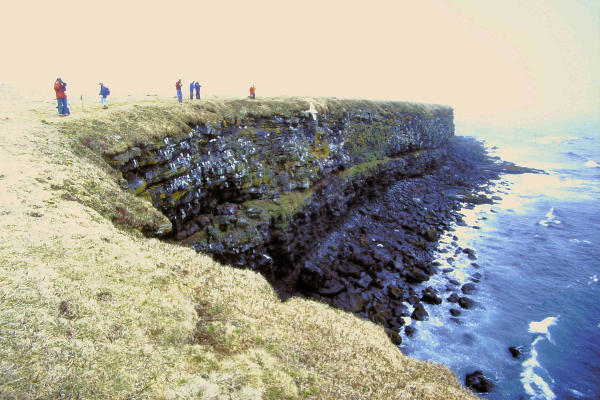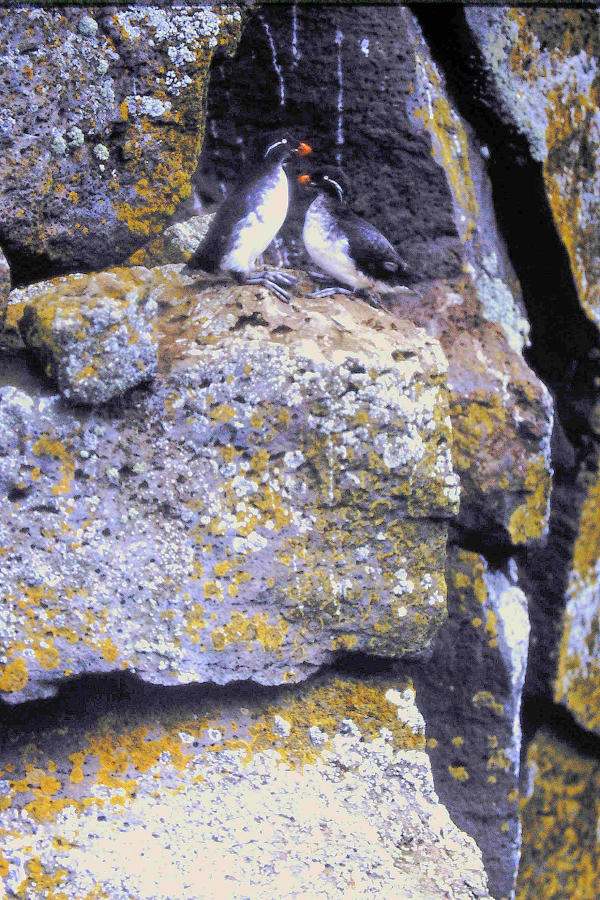
Birders observing and photographing nesting seabirds on the cliffs of St. Paul Island in the Pribilofs.

A pair of Parakeet Auklets at a potential nesting cavity.
|
As I awoke I peered out the port window to see a tall classic-shaped volcano rising up from the ocean, topped with snow and surrounded by low clouds and mist with thousands and thousands of seabirds swirling en masse round the fairy tale scene. It was a cool morning midway between Russia and Alaska, offshore the volcanic isle of Chagulak in the Aleutian Island chain. The birds were mostly Northern Fulmars, but other impressive seabirds were also in flight or feeding in the fertile Bering Sea waters, including Tufted Puffins, Crested Auklets, Parakeet Auklets, and an occasional Horned Puffin mixed into flocks.
At some locations the seabirds were feeding shoulder to shoulder on unseen invertebrates or fish near the surface. Many of these birds were nesting on the steep rocky cliffs of the island, including Black-footed Kittiwakes and Thick-billed Murres, and occasional Red-faced Cormorants and Glaucous-winged Gulls. Above the cliffs, on steep grass-covered slopes, thousands of Northern Fulmers nested, along with Horned and Tufted Puffins. While we were investigating the seabird flocks, the neighboring Amukta Volcano spewed a cloud of steam into the sky, as if the tens of thousands of birds flying, swimming, feeding and nesting weren’t enough excitement!
The island, which we called Chag for short, was a part of the Islands of Four Mountains, located about midway through the expansive Aleutian archipelago. We had already enjoyed day trips to such historic islands as Attu, Kiska and others, and we enjoyed seeing many of the impressive birds that these outlying islands of the United States provide.
We continued northward from the Aleutians across the Bering Sea to the legendary Pribilof Islands. As we cruised from island to island, we saw many of the aforementioned birds in the open sea, along with a scattering of impressive Laysan Albatrosses, a few Black-footed Albatrosses, and flocks of Short-tailed Shearwaters and Fork-tailed Storm Petrels.
On the Pribilof’s St. Paul Island we enjoyed observing and photographing remarkable nesting colonies of seabirds from above, looking over the edge of the sea cliffs from above. Yikes, I’m afraid of heights and it was a long way down to the sea coast. So that made it even more thrilling to study the nesting activities of rare Red-footed Kittiwakes, and Black-footeds too; plus Tufted and Horned Puffins; Parakeet, Crested and Least Auklets, along with Common and Thick-billed Murres.
Our last Bering Sea stop was the infamous birding location of Gambell, on the northwest point of St. Lawrence Island. Even before we arrived at Gambell, it was obvious we were in for some fantastic birding. I had two memorable sightings close to the ship as we approached St. Lawrence: A flock of rare Steller’s Eiders in flight paralleled the ship, providing a high level of excitement (for me especially). A short time later I sighted a flock of Emperor Geese flying close off the port side of the ship. I yelled the sighting loudly to birders within earshot, which precipitated a wild rush to the port side to enjoy the close view these exciting sea geese offered to everyone.
A funny footnote about the Emperor Goose sighting was that the ship’s German captain had never been around birders before. Not an hour earlier we spent some time photographing and observing Gray Whales with far less excitement among the passengers. So with that fresh in mind, the captain was so surprised at the reaction of passengers to the rare Emperor Geese that he couldn’t imagine what had happened with everyone excitedly running to one side of the ship. He confided in me later that he feared a whale had jumped on board considering the level of “hysteria.” The Emperors were life birds for most of the birders, and it was a species everyone hoped to see during this Bering Sea voyage, so birders were understandably excited and elated.
Once on site at the Gambell spit, the beach at the northwest point of St. Lawrence Island, we watched for rare birds such as the Asian species that are often described in our weekly ABA Rare Bird sightings for Gambell and St. Paul. During our vigil, we enjoyed views of many flocks of low-flying King Eiders, Brant, more Emperor Geese, Harlequin Ducks, White-winged Scoters, Tundra Swans, Pacific Loons and Parasitic Jaegers, along with a parade of murres, auklets and puffins. Even though we only spent a few hours on site, we did get to see one Asian passerine – a White Wagtail – a testimony to the Asian songbirds and flycatchers that have made this site famous among super-rarity birders. Formerly, Attu was THE place to go to find off-course Asian birds within the American realm but, unfortunately, Attu is no longer as easily accessible, so Gambell and St. Paul are now THE hotspots.
Seabirding is great fun, although we all appreciate that there are plenty of hours of bird-less skies for all the great sightings you do get at sea. All in all, though, these kinds of memorable experiences aren’t bad for a guy living as far away from an ocean as you can get – me. But for the record, I also lived on the edge of the Pacific Ocean from 1989 through 2013 in Seal Beach (south of Los Angeles) and Ocean Beach (San Diego). The ocean is an exciting draw to be sure, and the islands of the Bering Sea certainly have been an exciting birding destination – a few times.
Article and photographs by Paul Konrad
Share your birding experiences at editorstbw2@gmail.com